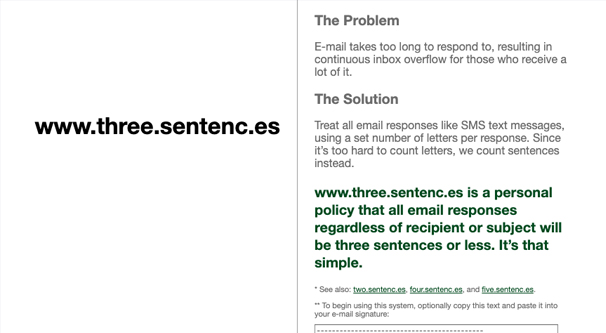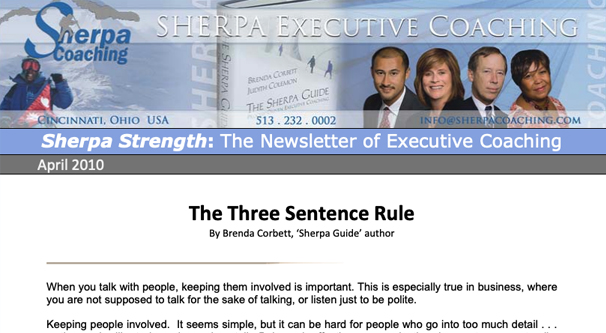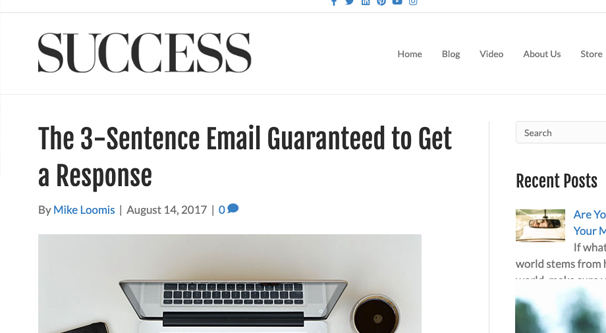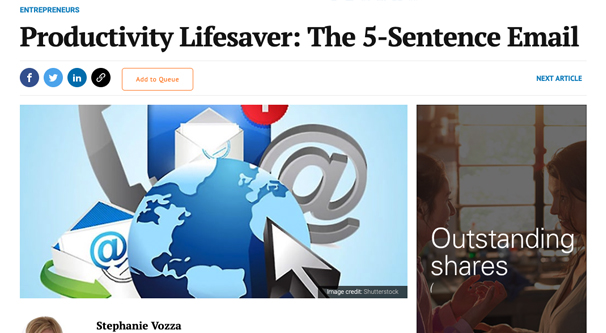How to Apply The 3 Sentence Rule to Your Emails

Email management is no joke, and one of the most difficult things to do is keep the amount of time you spend on it to a minimum each day. Some of us receive hundreds of emails a day, and I know some of the most popular entrepreneurs and business owners, even after filtering, may receive thousands.
Let’s say you receive 200 emails a day and have to reply to 100 of them. The ones you don’t have to reply to take you about 2 minutes to process. The ones you have to reply to take you 5 minutes. That’s 700 minutes of email per day, and that’s nearly 12 hours!
Now, this isn’t necessarily a realistic scenario, but it’s easy to see why email can stack up and why, once you reach a certain point, it’s easiest to simply stop responding to messages. Then again, this can lead to people sending more and more follow-up messages, leading to even more emails you have to deal with, and it just spirals out of control.
This is why so many people in frequent email communication adopt some fairly extreme policies. Some people strive to reach inbox zero by any means necessary, ignoring or deleting anything they can’t answer in a few seconds. Some people set up a complex network of autoresponders to trigger on keywords and deliver simple answers to common questions. Some people set up elaborate templates so they can fill out emails in a few seconds instead of a few minutes.
One such policy you can adopt is the Three Sentence Rule.
What Is The Three Sentence Rule?
The three sentence rule is a very simple rule. In fact, you can probably guess what it is just based on the name. Go ahead, I’ll wait. What do you think it is?
If you guessed “limit yourself to three sentences for every email you send,” you’re correct! The three sentence rule is simply a self-imposed limit of three sentences in any given email you choose to write.
Now, when you decide to adopt this kind of rule, you immediately notice a few things. First of all, it’s really hard! If you’re used to writing lengthy emails that include context, further reading, and citations for your recipient, it can be tricky to try to distill that down into three sentences.
In fact, in a lot of cases, you can’t really adequately cover a topic in three sentences. So then you find yourself confronting a related question: do you need to cover the topic?
The three sentence rule means you have to ask yourself a series of questions for every email you read before you reply.
- Is this an email I should be responding to? If you can’t answer it in three sentences or less, you have to decide what to do with it.
- What should I do with an email I’m not going to reply to? You can ignore it, you can delete it, or you can forward it to someone who is in a better position to handle it. In some cases, you can reply with a short email and a phone number, to encourage the sender to call you to hash out the question that way.
- Are there instances where I should violate the rule? Some people choose to stick to the rule as strictly as possible. Some people will make exceptions for certain circumstances, like a message from a publisher offering a book deal or a message from a potential business partner. It’s really up to you where you draw the line in the sand.
The primary purpose of the three sentence rule is not to regulate every single email, but rather to establish a baseline and some new habits that can allow you to deal with issues in a faster, more direct manner.
For example, I often find that a lot of people whom I would be sending a lot of context to don’t actually need all of that detail in the email. Either they already know or they don’t need to know, and either way, it’s a lot of extra words for no value. I can trust my recipients to be smart enough to look up relevant details, ask for clarification if they need it, and otherwise just understand what I’m telling them. Sometimes if they don’t get it, it means a failure on my part to explain adequately. I can learn and do better next time.
The three sentence rule is definitely not something you want to impose on, say, your sales team or your support team. People who need robust communications in order to do their job aren’t likely going to perform well when restricted to very short messages. It’s more for inter-personal and inter-business communications, outside solicitations, and other forms of communication.
Part of a successful three sentence email is knowing your audience. Who is receiving the email? What do they know, what do they need to know, and what should you tell them? Some people, you might not have all of this information for, and it can be tricky to know where to draw the line.
You can also consider the three sentence rule to be somewhat flexible, if necessary. This site promote the three sentence system, but it also has variations of the site for two sentences, four sentences, and five sentences. There’s nothing actually of substance to those websites, they’re just a way for you to add a disclaimer to your email signature and provide an explanation without needing a lengthy signature of your own.
Formatting Your Three Sentences
If you’re going to go with a three sentence rule, you might be thinking to yourself “how can I put together three sentences that do what I need them to do?”
It’s tricky, I will admit. As you practice at it you will get better at handling it, and once people know what you’re doing, they will get used to it. Until you get it down, though, you may find people accusing you of being terse, and others may find you off-putting. Still others will need repeated rounds of clarification, and you may run into the issue where one email turns into a chain of six or more.
There’s not much that can be done about this beyond dealing with it. The benefits of cutting most emails down to three sentences will generally outweigh the drawback of having to handle a couple more emails than you normally would. Plus, you may start to take your communication to other channels, like phone conversations, intra-office Slack channels, or other communications.
Still, though, some of you can benefit from some guidance or templates, so here are a few different ideas. One thing to keep in mind, though, is that different people have different concepts for what your three sentences should be.
First up, we have the Sherpa Coaching method. This comes from an executive coaching company and is thus aimed at executives communicating with those around them. For them, the three sentences are:
- The introduction. This is your one-sentence introduction to the topic at hand, not a greeting. Greetings and salutations are not part of your sentence quota.
- The theme. This is a sentence that states your point and what you’re trying to convey to your reader.
- The question. This is an engagement call to action that forces the recipient to consider what they read and decide if they have a response for you.
The Sherpa method is aimed not just at email, but for many forms of communication. I’ve seen it put to use by teachers who want to engage their classes; they bundle their modules of learning in three sentences and ask for further discussion with each. Here are some examples.
I’d like your opinion on an important matter relating to our customer service model. We’re looking to revamp our CS department and we’d like you to lead it. Are you up for headlining a reorganization?
I was reading your piece in the Washington Post and something struck me. You mentioned email management techniques, which I spearhead with my new tool. Would you be interested in giving it a try?
Now, I wouldn’t use that second example to pitch a guest post, but something like it might be enough to get a free trial in the hands of someone who could become a valuable customer or testimonial in the future. It’s all about context.
Now a second alternative method, the Success Method. This one comes from success.com and uses slightly different categories for each sentence.
- The Why. The first sentence is a punchy line that tells the recipient why you’re interrupting them with an email and why they should care about it. It also often includes some element of a personal connection with the recipient, especially for cold emails.
- The Who. This second sentence is preemptively answering the question that the recipient is going to ask, namely, “who are you and why should I care about this email?”
- The What. This third sentence is your question, your call to action, the purpose of the email. In the second sentence you established who you are and why they should give you their attention, and this is what you’re using their attention for.
This method is primarily aimed at cold emails and marketing outreach. It’s a simpler form of guest post outreach but tends to be a good way to get a foot in the door with certain kinds of time-pressed entrepreneurs and editors. It shows that you respect the time of the person you’re reaching out to, so you aren’t including a ton of extraneous details. Items like your company, your role, your website, and so on can all be included in your email signature or can be looked up independently if you’ve caught the recipient’s attention. Again, some examples:
I was recently reading your post titled “Why Cryptocurrencies Are the Future” and it sparked some inspiration. My business has dealt with Crypto since its inception, but I’ve always wondered about how we can go about improving its reputation. I was wondering if you’d be up for a brief interview on the subject?
I’ve been a long-time reader of your blog, and my friends love it too. You recently covered my business in one of your top-five lists (found here), and I really appreciate it! I’d love to write something for your blog, would you be interested in a contribution?
Overall, the three sentence rule doesn’t need to have specific rules, roles, or goals for each sentence. The point is to limit yourself, and having some guidance can help with that, but you should never consider these methods to be set in stone. If you need to use four sentences for an important contact, go ahead. If you can solve a situation with a single sentence, why not do so?
The three sentence email is a goal, but the point of the goal is to be comfortable in a short format. If you want to run with a five sentence format instead, that exists too. You can go with the standard Who/What/When/Where/Why, or you can customize it with something like “Who am I, What do I want, Why am I asking you, Why should you consider my proposition, and What you should do about it” as your five. Again, it’s all about what works best for you and helps you cut your communications time down to only an hour instead of twelve.






